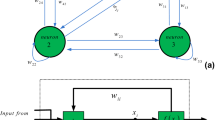Abstract
In this paper, chaos in a new class of three-dimensional continuous time Hopfield neural networks is investigated. Numerical experiments show that this class of Hopfield neural networks can have chaotic attractors and limit cycles for different parameter configurations. By virtue of horseshoes theory in dynamic systems, rigorous computer-assisted verifications are done for their chaotic behavior. In terms of topological entropy, quantitative interpretations of these neural networks’ complexity are given. A brief analysis is also presented about their robustness.







Similar content being viewed by others
References
Hopfield JJ (1982) Neural networks and physical system with emergent collective computational abilities. Proc Natl Acad Sci USA 79:2554–2558. doi:10.1073/pnas.79.8.2554
Amari S (1990) Mathematical foundations of neurocomputing. Proc IEEE 78:1443–1448. doi:10.1109/5.58324
Doi S, Kumagai S (2005) Generation of very slow neuronal rhythms and chaos near the Hopf bifurcation in single neuron models. J Comput Neurosci 19(3). doi:10.1007/s10827-005-2895-1
He G, Shrimali MD, Aihara K (2007) Partial state feedback control of chaotic neural network and its application. Phys Lett A 371(3):228–233
Korn H, Faure P (2003) Is there chaos in the brain? II. Experimental evidence and related models. C R Biol 326:785–840
Wu WJ, Chen ZQ, Yuan ZZ (2008) A computer-assisted proof for the existence of horseshoe in a novel chaotic system. Chaos Solitons Fractals. http://www.elsvier.com/locate/chaos. Accessed 22 November 2008
Yuan Q, Li Q, Yang X-S (2008) Horseshoe in a model of artificial neural network. Appl Math Model 32(7):1395–1402. doi:10.1016/j.apm.2007.06.008
Marro J, Torres JJ, Cortés JM (2007) Chaotic hopping between attractors in neural networks. Neural Netw 20(2):230–235. doi:10.1016/j.neunet.2006.11.005
Liu X, Xiu C (2007) A novel hysteretic chaotic neural network and its applications. Neurocomputing 70(13–15):2561–2565. doi:10.1016/j.neucom.2007.02.002
Bersini H, Sener P (2002) The connections between the frustrated chaos and the intermittency chaos in small Hopfield networks. Neural Netw 15(10):1197–1204. doi:10.1016/S0893-6080(02)00096-5
Wang J, Chen L, Jing Z (2001) Chaos and asymptotical stability in discrete-time recurrent neural networks with generalized input–output function. Sci China Ser A Math 44(2). doi:10.1007/BF02874421
Liao Z, Huang Y (2008) Horseshoe and topological entropy estimate of a class of three-dimensional cellular neural networks. Appl Math Comput 197(1):382–388. doi:10.1016/j.amc.2007.07.077
Li QD, Yang XS et al (2005) Hyperchaos in Hopfield-type neural networks. Neurocomputing 67:275–280. doi:10.1016/j.neucom.2005.02.009
Yang X-S, Yuan Q (2005) Chaos and transient chaos in simple Hopfield neural networks. Neurocomputing 69:232–241. doi:10.1016/j.neucom.2005.06.005
Yang X-S, Huang Y (2006) A new class of chaotic simple 3-neuron cellular neural network. Int J Bifurcat Chaos 16(4):1019–1021. doi:10.1142/S021812740601526X
Yang X-S, Li Q (2006) Horseshoe chaos in cellular neural networks. Int J Bifurcat Chaos 16(1). doi:10.1142/S0218127406014666 (in press)
Hopfield JJ (1984) Neurons with graded response have collective computational properties like those of two-state neurons. Proc Natl Acad Sci USA 81(10):3088–3092. doi:10.1073/pnas.81.10.3088
Yang X-S, Tang Y (2004) Horseshoes in piecewise continuous maps. Chaos Solitons Fractals 19(4):841–845. doi:10.1016/S0960-0779(03)00202-9
Yang X-S, Li H-M, Huang Y (2005) A planar topological horseshoe theory with applications to computer verifications of chaos. J Phys Math Gen 38:4175–4185. doi:10.1088/0305-4470/38/19/008
Eckmann JP, Ruelle D (1985) Ergodic theory of chaos and strange attractors. Rev Mod Phys 57(3):617–656. doi:10.1103/RevModPhys.57.617
Wiggins S (1990) Introduction to applied nonlinear dynamical systems and chaos. Springer, New York
Robinson C (1995) Dynamical systems: stability, symbolic dynamics, and chaos. CRC Press, Boca Raton
Acknowledgments
The research was funded by National Science Foundation of China (60875009) and the great project of Hubei Provincial Department of Education (Z20081301). The authors are very grateful to the reviewer for the valuable comments and suggestions.
Author information
Authors and Affiliations
Corresponding author
Rights and permissions
About this article
Cite this article
Dan, Z., Huang, W.z. & Huang, Y. Chaos and rigorous verification of horseshoes in a class of Hopfield neural networks. Neural Comput & Applic 19, 159–166 (2010). https://doi.org/10.1007/s00521-009-0269-8
Received:
Accepted:
Published:
Issue Date:
DOI: https://doi.org/10.1007/s00521-009-0269-8




